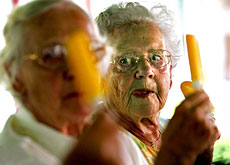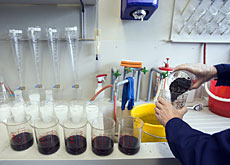Ozone continues to cause summertime blues

The hotter the summer, the more ozone is in the air. But unlike in the 1980s, the irritant is no longer high on the political agenda.
Organisations such as the Swiss Lung League want to change this and are calling for a series of measures to reduce the amount of ozone in Swiss air.
Since the beginning of July ozone levels in many places in Switzerland have climbed above 200 micrograms per cubic metre. The limit is 120.
This can be unpleasant or even dangerous for people who suffer from lung or breathing problems. It can also be harmful for children under five, as their lungs aren’t fully developed.
In the 1980s, efforts to combat ozone made headlines; now, reports and warnings about summer’s “unloved guest” end up in the “news in brief” section.
Lowering the speed limit on motorways from 120 km/h to 80 km/h is barely discussed – either in parliament or in the pub.
“Many people consider ozone a side effect of hot weather. They’re unaware that it’s a harmful air pollutant,” Cornelis Kooijman from the Swiss Lung League told swissinfo.ch.
Symptoms
The aim of his association and other organisations is to make the public aware of the health problems associated with ozone – typically weaker lung power – via information campaigns and political demands.
Symptoms can range from watery eyes and a runny nose to asthma attacks. Kooijman adds that ozone can trigger not only inflammation in the lungs and air ways but also aggravate a person’s sensitivity to other air pollutants and pollen.
If you find yourself suffering from breathing problems, Kooijman suggests you consult a doctor to clarify the cause of the symptoms.
Even better is to follow guidelines to avoid or minimise ozone-related problems.
“Try to do physically demanding work in the morning, when ozone levels are still low.” This is Kooijman’s main rule. This also applies to hobby athletes.
Parents’ role
He also appeals to parents’ sense of responsibility. “Since heat goes hand in hand with ozone levels, kids shouldn’t be exposed to any great exertions,” he said.
Kooijman doesn’t want to be a party pooper for small children, but he encourages parents to only let them go swimming before midday.
Otto Brändli, a respiratory expert and president of the Zurich Lung League, also has clear advice. “Levels above 180 micrograms per cubic metre can lead to detectable damage for sensitive people,” he said.
Brändli recommends staying at home with children under five when the ozone level is high.
Electric gadgets
Kooijman admits that the peak levels of the 1980s – when 400 micrograms per cubic metre were measured in Ticino – belong to the past.
Car engines that emit fewer pollutants and obligatory catalysers for new cars are the main reason for the trend.
“The government and cantons have done a lot to reduce pollutants. They take their responsibility seriously,” he said.
He criticises however the fact that levels haven’t gone down for ten years. “Further long-term measures are needed for the reduction of air pollutants, especially nitrogen dioxide, since limits continue to be exceeded.”
The Lung League is therefore calling, among other measures, for the obligatory fitting of all diesel engines with particle filters and special catalysers to filter out nitrogen dioxide.
Another demand is limiting the use of two-stroke engines, which churn out nitrogen dioxide.
Kooijman is urging not only the government to do its bit, but also the man and woman in the street. “We advocate the use of electric gadgets such as lawn mowers or hedge clippers.”
This will result in a reduction in harmful emissions – although the neighbours will still have to put up with the noise.
Renat Künzi, swissinfo.ch (Translation from German by Thomas Stephens)
“Bad” ozone
Ozone is found in the troposphere, which is the lowest region of the atmosphere, extending from the earth’s surface to a height of about 6-10km.
Ozone is not generated directly by human activity, but forms as a result of prolonged exposure to the sun, first of all from nitric oxide and volatile organic compounds (VOC).
The main cause of nitric oxide emission is motorized traffic, whereas industry and households generate VOC.
The effects on humans include irritation of the mucous membranes, inflammation of the respiratory tract, reduction of the lungs’ function and physical performance.
“Good” ozone
Stratospheric ozone is found in the higher regions of the atmosphere and protects us from ultraviolet rays.
Over the past few years, this type of ozone has been reduced considerably (the famous ozone hole), owing to an excessive use of substances such as chlorofluorocarbon (CFC).

In compliance with the JTI standards
More: SWI swissinfo.ch certified by the Journalism Trust Initiative













You can find an overview of ongoing debates with our journalists here . Please join us!
If you want to start a conversation about a topic raised in this article or want to report factual errors, email us at english@swissinfo.ch.